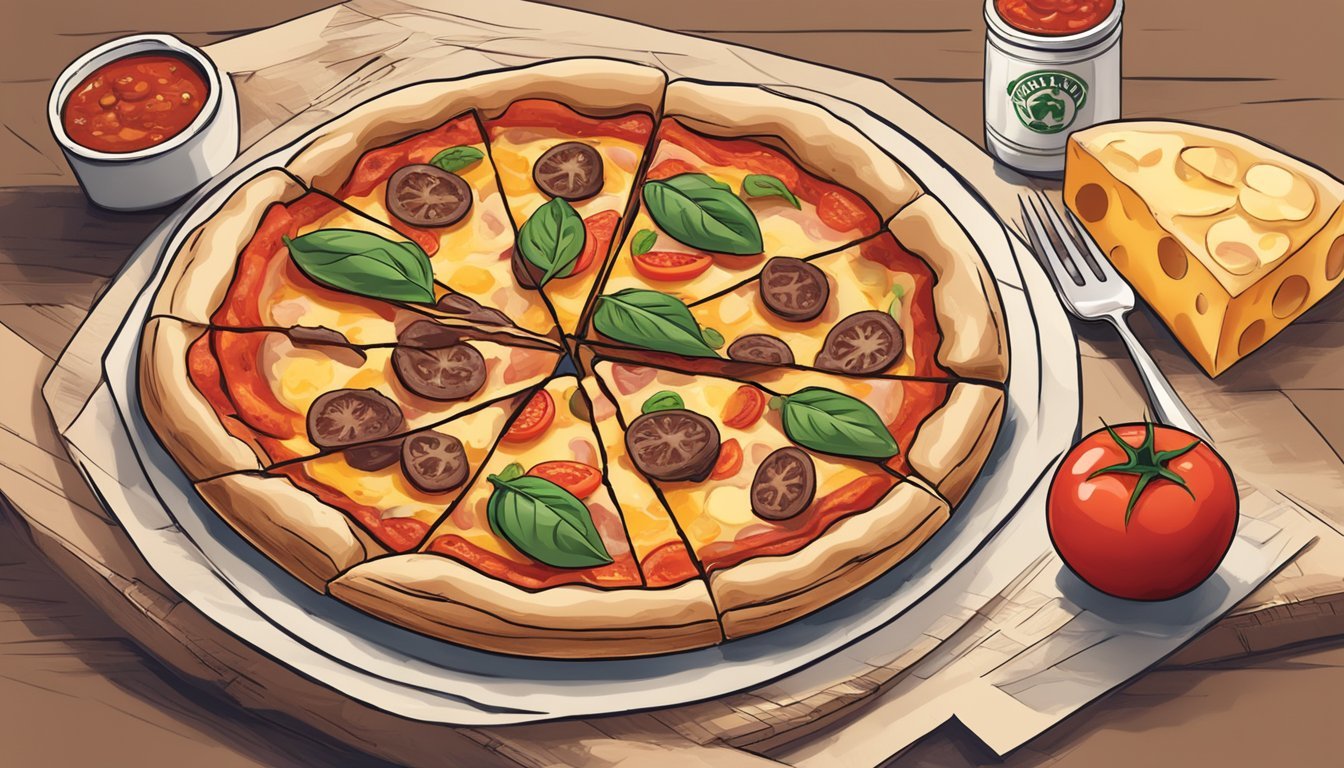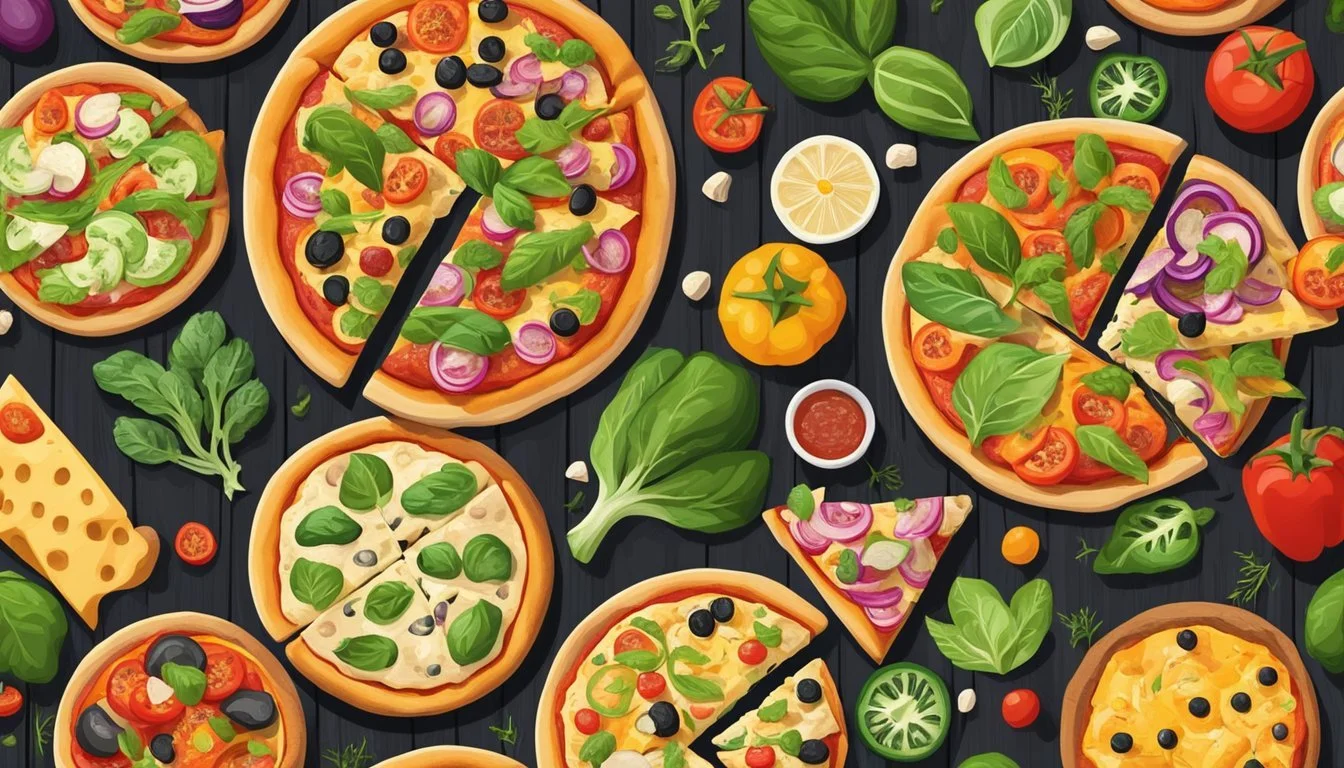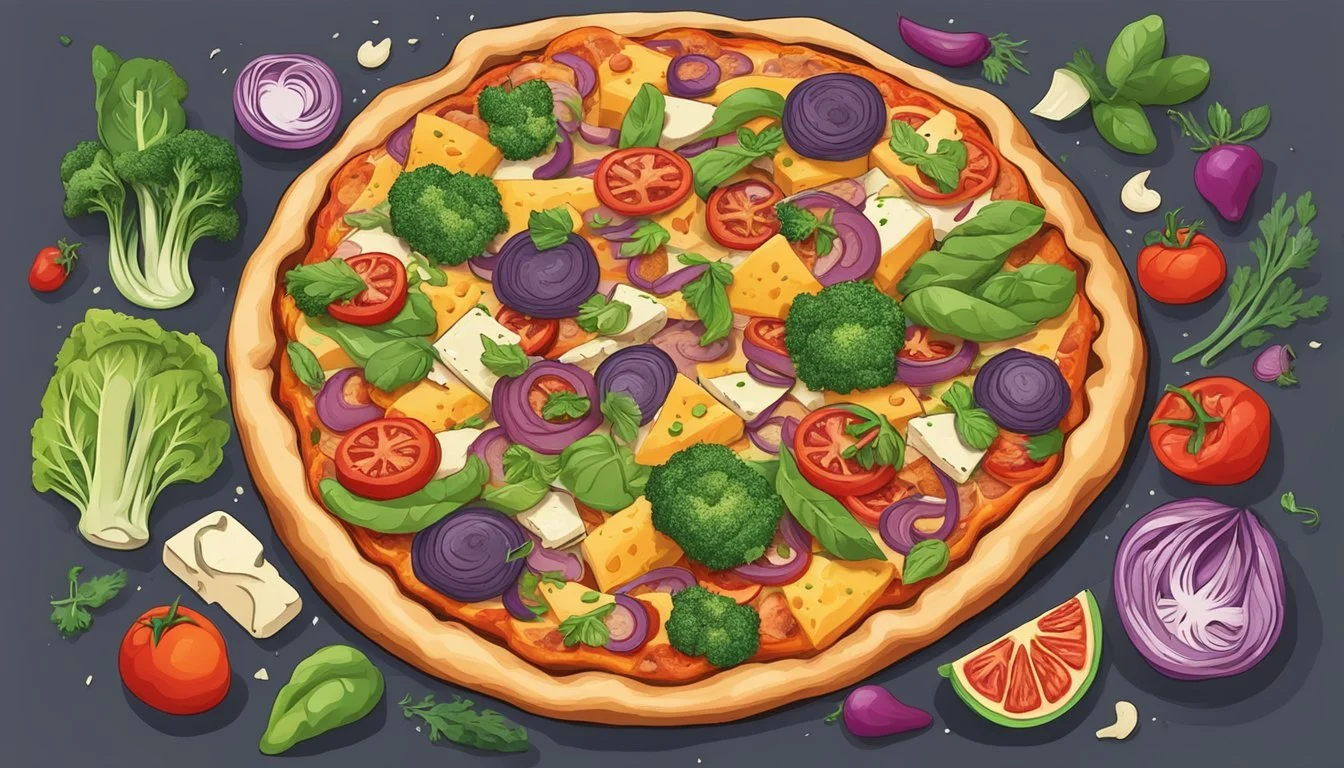Is Meat Lover's Pizza Vegan?
Unpacking the Ingredients
Traditionally, a meat lover's pizza (What wine goes well with pizza?) is a celebration of various types of meat toppings, such as pepperoni, sausage, ham, and bacon, among others. This pizza is known for its rich, savory flavors and is a popular choice at many pizza establishments. However, the concept of a meat lover's pizza doesn't inherently exclude it from being vegan-friendly. In recent years, the rise of plant-based diets and the demand for vegan products have led food innovators to recreate this classic pizza option without animal ingredients.
The vegan version of a meat lover's pizza uses plant-based proteins to mimic the taste and texture of traditional meat toppings. These plant-based alternatives are created using ingredients like soy, peas, wheat, and other natural sources, resulting in a product that caters to both the dietary restrictions and ethical considerations of vegans. In addition to vegan meats, dairy-free cheese substitutes are used to achieve the creamy, melted quality of cheese usually found on pizzas. These substitutes are often made from nuts, soy, or starches and are designed to melt and stretch similarly to dairy cheese.
With the availability of these plant-based products, pizza lovers can enjoy a meat lover's pizza that is completely devoid of animal products, making it both vegan and dairy-free. Grocery chains and local pizzerias alike are increasingly offering these vegan meat lover's pizza options, recognizing the growing consumer interest in plant-based foods. The result is a pizza that aims to satisfy the taste preferences of both traditional meat lovers and those following a vegan lifestyle.
Understanding Veganism
In the context of dietary choices, veganism is characterized by the exclusion of all animal products, favoring plant-based alternatives and specially designed meat substitutes.
The Vegan Diet
A vegan diet is plant-based and excludes all animal products, meaning no meat, dairy, eggs, or honey. Individuals following this diet opt for vegetables, fruits, grains, legumes, nuts, and seeds to fulfill nutritional requirements. Vegan cheese and vegan mozzarella are popular dairy-free options that replicate the texture and taste of traditional cheese using ingredients like nuts and plant oils.
Plant-Based Alternatives
Plant-based alternatives refer to foods designed to replace animal-derived ingredients. These include dairy-free milks such as almond, oat, and soy milk, as well as vegan butters and yogurts. This category also encompasses vegan cheeses made from various plant sources, which allow those on a vegan diet to enjoy flavors and dishes that traditionally require dairy.
Meat Substitutes Used in Vegan Cuisine
Vegan cuisine commonly utilizes meat substitutes to recreate the flavors and textures of meat-based dishes without animal products. These substitutes include:
Vegan pepperoni: Made from plant proteins like soy or seitan (What wine goes well with seitan?) and seasoned to mimic the taste of pepperoni.
Vegan sausage: Often created from mushrooms, soy protein, or lentils, providing a similar texture to traditional sausage.
Meatless products: Crafted from a blend of plant proteins, they can vary in form, whether it's chunks, patties, or ground-style.
These alternatives not only cater to vegans but also those looking to reduce meat consumption due to health or environmental reasons.
Components of a Meat Lover's Pizza
A meat lover's pizza is a hearty option renowned for its generous assortment of meat toppings and a robust cheesy foundation, all supported by a traditional pizza base.
Traditional Meat Toppings
The defining characteristic of a meat lover's pizza is its rich variety of meats, which often include:
Pepperoni: Thinly sliced, highly seasoned with spices like paprika and chili pepper, adding a smoky flavor.
Sausage Crumbles: Typically made from ground pork, both Italian sausage and other seasoned sausage crumbles contribute a spicy and savory depth.
Italian Sausage: Known for its fennel seeds and blend of herbs, it introduces a robust taste.
Bacon: It imparts a crispy texture and a salty, smoky tang.
Cheese and Sauce Basics
A meat lover's pizza is typically layered with:
Mozzarella Cheese: A staple for its melty and stretchy qualities, offering a mild, creamy taste.
Pizza Sauce: A variant of Tomato Sauce, usually seasoned with a blend of Italian herbs, garlic, and onions, serves as the flavor-intensifying base.
Pizza Dough and Crust
The dough is the foundation upon which a meat lover's pizza is built:
Dough: Refined for its ability to rise and bake into a soft yet stable base, with the option for variations like whole wheat or gluten-free.
A Crispy Crust is achieved through baking at high temperatures, resulting in a pleasing crunch that complements the rich toppings.
Analyzing Meat Lover’s Pizza Vs. Vegan Pizza
Traditional meat lover's pizza is a hearty option known for its generous array of meats, while vegan pizza replaces these with plant-based alternatives to fit a vegan diet.
Key Differences
Ingredients: Meat lover's pizza typically includes pepperoni, sausage, ham, and bacon, all high in calories, saturated fats, and cholesterol. Vegan pizza, on the other hand, utilizes substitutes like vegan pepperoni, sausage, and sometimes even plant-based chorizo or bacon, which are made from various plant proteins.
Cheese: The cheese on a meat lover's pizza is usually made from dairy, whereas vegan pizzas use vegan mozzarella shreds or other types of vegan cheese, often based on nuts or soy.
Taste and Texture Considerations
Flavor Profile: Some consumers may notice a taste difference between the authentic meats and their vegan counterparts due to the plant-based ingredients used. However, advances in food technology have led to vegan meats that closely mimic the flavor and savory notes of real meat.
Texture: Vegan meats and cheeses have improved significantly in mimicking the texture of their traditional counterparts, though there may still be slight differences. For example, vegan cheese may not melt in exactly the same way as dairy-based cheese.
Creating a Vegan Meat Lover's Pizza
When it comes to satiating the cravings of a meat lover while adhering to a vegan diet, a well-crafted vegan meat lover's pizza can be both satisfying and delicious. It includes meat alternatives, dairy-free cheeses, and distinct flavors that closely mimic traditional pizzas.
Vegan Meat Alternatives
For those seeking the savory taste of meat without compromising their vegan values, plant-based proteins serve as excellent substitutes on a pizza. A popular choice is meatless pepperoni slices, which add a spicy kick to each bite. Vegan sausage crumbles and soy chorizo also offer the hearty texture and flavors typical of meat toppings, all while being completely plant-derived. These ingredients can be found in most health food stores and an increasing number of mainstream grocery chains.
Key Vegan Meats for Pizza:
Meatless Pepperoni Slices
Vegan Sausage Crumbles
Soy Chorizo
Dairy-Free Cheese Options
No pizza is complete without a generous sprinkle of cheese. Vegan mozzarella makes for an ideal stand-in for traditional dairy-based mozzarella, thanks to its ability to melt and stretch. It often incorporates ingredients such as cashews, almond milk, or soy protein, aiming to replicate the creamy texture and mild taste of its dairy counterpart. For those looking for variety, a combination of different dairy-free cheeses can provide additional depth and richness.
Example Vegan Cheeses:
Vegan Mozzarella Shreds
Cashew-Based Cheese
Almond Milk Cheese
Homemade Vegan Pizza Recipes
Creating one's own vegan meat lover's pizza at home begins with selecting a robust crust as the foundation. Spread a layer of rich tomato sauce onto the crust, leaving a small border for the crust to rise. Then, artfully arrange the chosen vegan meat alternatives—such as meatless pepperoni, soy chorizo, and plant-based sausage—over the sauce. Generously top with dairy-free cheese, focusing on vegan mozzarella for its smooth melting qualities. Bake in a preheated oven until the cheese is suitably melted and the crust reaches a golden-brown hue, typically at a high temperature of around 450º F. Homemade recipes give the freedom to adjust toppings and flavors to one's preference, ensuring each pizza is as unique as its creator.
Basic Steps for Homemade Pizza:
Roll out the pizza dough and place it on a pizza pan or baking sheet.
Spread the tomato sauce, leaving a border for the crust.
Add vegan meat toppings.
Sprinkle with dairy-free cheese.
Bake at 450º F until golden and cheese has melted.
Popular Vegan Pizza Brands
The variety of vegan pizzas available on the market has grown significantly, with brands developing plant-based alternatives that cater to meat lovers' preferences without using animal products. These options balance flavor and dietary choices, offering both convenience and culinary innovation.
Frozen Vegan Meat Lover's Pizzas
Sweet Earth and Trader Joe's are notable for their frozen vegan meat lover's pizza options. Sweet Earth specializes in plant-based pizzas such as the Vegan Meat Lovers Pizza, which is loaded with proteins derived from plants instead of traditional meat. Trader Joe's has also entered the fray with its Vegan Pizza selections that highlight a bounty of vegetables.
Sweet Earth: Offers a meat lovers' pizza with plant-based proteins, providing a satisfying alternative to traditional meat toppings.
Trader Joe's: Their pizzas, like the Veggie Pizza of the Day, feature an array of vegetables and are a testament to vegan variety, sometimes including unexpected ingredients like hummus.
Plant-Based Pizzerias and Restaurants
Beyond traditional frozen options, plant-based pizzerias and restaurants are creating waves in the food industry. These establishments often partner with innovative brands like Beyond Meat and Impossible Foods to create vegan pizza offerings that mimic the taste and texture of meat. For example, restaurants serving pizzas with Beyond sausage or Impossible beef crumbles cater to those who prefer plant-based diets without sacrificing the meaty flavors they enjoy.
Pizzerias may feature Beyond or Impossible meats on their vegan pizzas, making them a desirable choice for meat lovers who are looking to eat plant-based. These options highlight the advancements in vegan food technology.
Some restaurants also craft their own in-house vegan meats, contributing to the unique palette of vegan products available to consumers who choose to dine out. They may also offer additional vegan options like Hold the Dairy! cheese alternatives to ensure that every aspect of the pizza is plant-based.
Nutritional Profile of Vegan Meat Lover's Pizza
Vegan Meat Lover's Pizza typically substitutes animal-based toppings with plant-based proteins, making it a suitable option for those following a vegan lifestyle while aiming to replicate the flavors of a traditional meat lover's pizza.
Caloric and Macro Nutrient Breakdown
A vegan Meat Lover's Pizza generally has a caloric value that can vary based on the toppings and crust used. A standard serving contains:
Calories: Range between 200-300 per slice
Protein: 10-20 grams per slice
Carbohydrates: 25-40 grams per slice
Of which sugars: A minimal amount, as savory pizzas do not typically contain added sugars
Fat: 5-15 grams per slice
Saturated fat is typically less than that found in traditional meat pizzas due to the plant-based toppings
Dietary Fiber is present in varying amounts, often higher in pizzas with whole-grain crusts and plentiful vegetable toppings.
Health Benefits and Considerations
The plant-based proteins used on a Vegan Meat Lover's Pizza, including alternatives such as soy, peas, and wheat, contribute to the protein content while reducing the intake of cholesterol and animal fats. These proteins can offer a full amino acid profile, and when combined with other ingredients of a pizza, result in a nutritionally dense meal.
However, vegan products are not uniformly low in sodium or calories. It's essential for individuals to review the nutritional facts of specific brands as some may add significant amounts of sodium or fats to enhance flavor. A balanced vegan pizza should still be part of a well-rounded plant-based meal plan, ensuring variety and overall nutritional adequacy.
Consumer Insights and Market Trends
The landscape for meat lover's pizza is shifting, with vegan options increasingly gaining traction. This section delves into how social media and customer reviews are influencing the market and reflecting consumer behavior.
Social Media Influence
Social media platforms, particularly Instagram, have become pivotal in shaping food trends and consumer preferences. Instagram's visual appeal allows food brands to showcase their vegan meat lover's pizzas, tapping into the aesthetic value foodies seek. This has led to a growing number of posts and shares, which amplifies interest and curiosity among potential customers.
Customer Reviews and Feedback
Customer reviews are critical in guiding others towards or away from a product. For instance, the introduction of Trader Joe's vegan meat lover's pizza priced at $5.99, has garnered attention and feedback across multiple review platforms. These reviews are a barometer of satisfaction and act as powerful word-of-mouth marketing, helping others make informed decisions based on firsthand experiences.
Vegan Pizza in Culinary Culture
Vegan pizza is taking its place at the table alongside traditional culinary staples, reflecting a broader trend towards plant-based dining that does not compromise on the flavors and experiences diners love.
The Rise of Plant-Based Dining
The culinary landscape has been witnessing a significant shift with the rise of plant-based dining. Consumers are increasingly opting for vegan options, both for ethical reasons and health considerations. This surge in demand has resulted in a proliferation of vegan alternatives that go beyond simple salads or vegetable sides. Innovative creations like vegan pasta bolognese and vegan enchilada casserole are becoming menu mainstays in restaurants worldwide, illustrating the versatility and appeal of vegan cuisine.
Italian Eateries: Traditionally known for their dairy and meat-based dishes, Italian restaurants are introducing vegan alternatives such as vegan pizza, which maintain the essence of the country’s culinary heritage while staying in line with modern dietary preferences.
Incorporating Vegan Options in Traditional Menus
Traditional menus are evolving as chefs and restaurateurs increasingly recognize the importance of catering to diverse dietary needs. Veganism is no longer considered a fringe dietary choice but a mainstream demand that restaurants are integrating into their offerings.
Menu Highlights:
Vegan Meat Lovers Pizza: Once an oxymoron, it is now a popular dish made with plant-based proteins emulating the flavors of meat.
Cheese Options: Vegan pizzas often feature a variety of plant-based cheeses, designed to replicate the meltability and richness of dairy-based cheeses.
In summary, by adapting their menus to include vegan options like pizza, traditional restaurants are not only staying relevant but are also participating in a gastronomic movement that celebrates inclusivity and sustainability without sacrificing flavor.
Cooking Tips and Tricks
When crafting a meat lover's vegan pizza, the foundation is just as important as the toppings. A perfect crust and strategic layering of flavors determine the quality of the final product.
Preparing the Perfect Vegan Pizza Crust
A vegan pizza crust is the canvas for your toppings. Key considerations for the crust include:
Texture: For a crispy base, preheat your oven to a high temperature—450°F (232°C) is optimal. This ensures a crust that's crunchy on the outside and soft on the inside.
Ingredients: Use a simple dough mixture of flour, water, yeast, salt, and a touch of olive oil for elasticity. Adding a hint of garlic can give the crust an extra flavor dimension.
Rolling out: Divide the dough into equal portions and roll each to fit your pizza pans. A uniformly thin crust promotes even cooking.
Selecting and Layering Toppings
The right toppings transform your pizza into a hearty vegan feast. Here's how to build up the flavors:
Sauce: Begin with a robust tomato sauce, covering all but the outer 1/2 inch of the crust.
Proteins: Layer plant-based pepperoni, sausage, and bacon evenly to mimic traditional meat textures.
Vegetables: Add nutritional depth with vegetables like kale, caramelized onions, and cauliflower.
Cheese: Sprinkle a generous amount of vegan shredded mozzarella evenly across the toppings.
Final Touch: A light drizzle of olive oil on the edges of the crust adds a golden hue post-baking.
When assembling, use a cutting board for stability and a spatula for easy transfer to baking sheets. Remember, bake until the cheese is melted and the crust is golden brown for a truly satisfying vegan meat lover's pizza.








